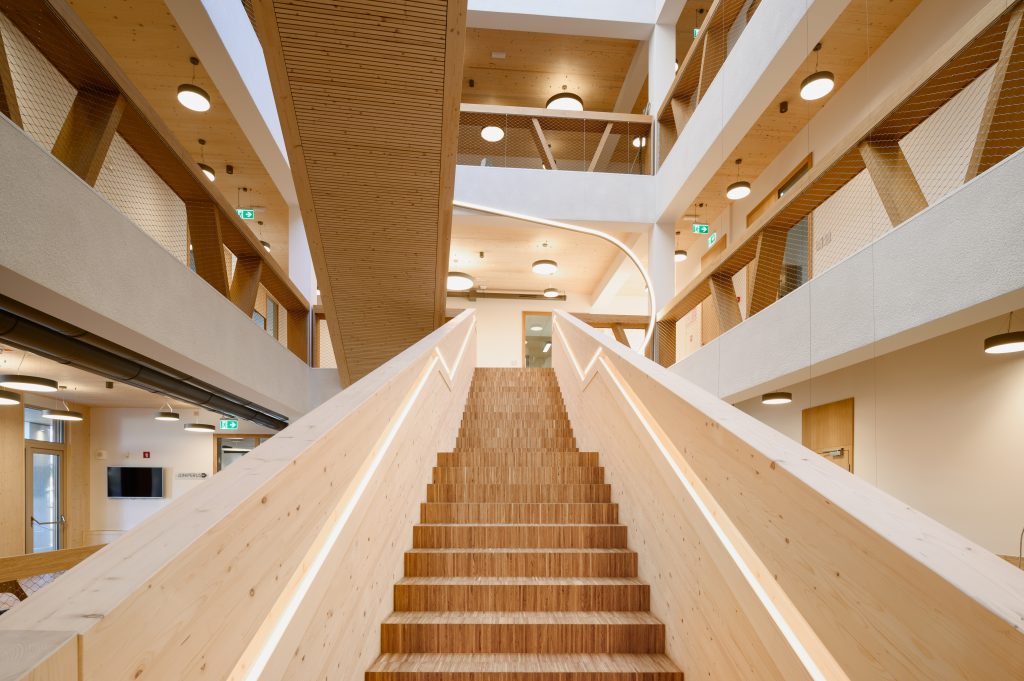
January 7, 2026

The InnoRenew CoE research laboratories include also a Composites Laboratory which houses equipment for the preparation of composites, testing of products used in structures, and treatments to improve the performance of bio-based products. Flexibility and a focus on wood-based products was the focus of this lab and ranges from small to large scale operations.
Composite materials and engineered wood products can achieve great levels of performance and greater reliability due to their engineered layups and uniform distribution of weaknesses that naturally occur in solid wood. This distribution occurs by shaping the wood to the desired geometry via cutting or grinding. For cutting we have a fully equipped wood-processing workshop that can process wood all the way from raw logs to laboratory test pieces. If grinding is needed the Composites Laboratory has grinders that can handle small branches and boards and grind them all the way down to less than a millimeter. If the composite layup requires an exact distribution of these ground pieces, the lab also contains a large sieve system which can fractionate the material to gather your desired size range.
The next step of most composites after comminution or cutting is re-consolidation into the desired form. For panel products this is typically done using a heated press that applies a desired force to achieve the correct pressure. The Composites Laboratory has a smaller 60 cm x 60 cm hot press with a 30 T capacity and a large press with 150 cm x 90 cm with a 270 T capacity. Both presses are designed to do simple panel production with heating and pressure but have also been custom designed to run thermos-hydro-mechanical (THM) treatment programs which require rapid heating and cooling while under pressure. InnoRenew has previously used these types of THM treatments in these presses to enhance the strength, dimensional stability, and durability of relatively weak and low-density wood species, like Poplar.
Beyond panel production, this laboratory also has a research-oriented polymer composite system. This setup can process small batches of test blends of polymers/fillers/reinforcements, blend them, extrude, pelletize, and either injection mold into test samples or spool into 3D printing filaments. Specialised feeders allow careful metering and feeding of low-density materials which is common in bio-based materials. Researchers have used this equipment for a variety of studies including modified lignin used in bio-based polymer packaging, blending of heat-treated wood with compostable polymers, etc.
This laboratory also houses devices for the modification of materials for use in composites and other products. The first device of note is our tube furnace. This furnace heats bio-based materials to very high temperatures in the absence of oxygen to convert them into activated, high-carbon content materials. This activation increases reactivity and conductivity which leads to many interesting applications including high-performance soil amendments, water and indoor air purification, and even printed electronic circuits. The second type of devices used for modification in this lab are our reactors. These jacketed reactors are akin to pressure cookers and can be used for many modification and extraction techniques including fermentation, extraction of bio-based compounds (e.g., lignin, polyphenols), cleansing of media, growth of protective fungal cells, etc.
The final category of equipment can be classified as monitoring or testing of composites and materials. This includes our hydraulic, mechanical testing setup and our accelerated weathering machine. The mechanical test setup is a modular, highly adaptable collection of steel columns and beams that can create custom testing geometries for larger products like beams or wall segments. Using dynamic loading and static actuators, we can then apply forces in any configuration we wish. Nearby is the accelerated weathering device that is another way products can be assessed with respect to their resistance to environmental impacts such as UV radiation, rain, condensation, humidity, and heat. By exposing specimens to these conditions, we can determine how effective new and exiting wood treatments and/or modifications are in protecting the wood from the environment.
In general, this lab serves as a production and test facility for larger sized products that require a more industrial type of space than a typical chemistry laboratory could offer. The work done in this lab can help support the development of new composite prototypes, application of new and different adhesives used in composites, assessment of a product’s potential performance outdoors, creation of air purifying coatings, or even the development of fermented cultures that can lead to bioactive coatings!
List of equipment in the Composites Laboratory
Dr. Matthew Schwarzkopf, InnoRenew CoE